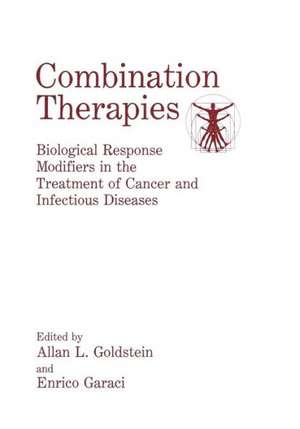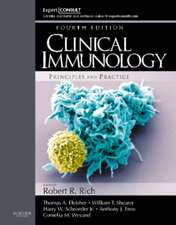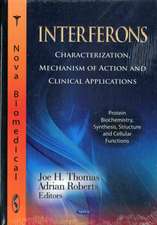Combination Therapies: Biological Response Modifiers in the Treatment of Cancer and Infectious Diseases
Editat de E. Garaci, Allan L. Goldsteinen Limba Engleză Paperback – 21 oct 2012
Preț: 375.34 lei
Preț vechi: 395.09 lei
-5% Nou
Puncte Express: 563
Preț estimativ în valută:
71.82€ • 75.18$ • 59.78£
71.82€ • 75.18$ • 59.78£
Carte tipărită la comandă
Livrare economică 31 martie-14 aprilie
Preluare comenzi: 021 569.72.76
Specificații
ISBN-13: 9781461364726
ISBN-10: 1461364728
Pagini: 332
Ilustrații: XV, 313 p.
Dimensiuni: 178 x 254 x 17 mm
Greutate: 0.58 kg
Ediția:Softcover reprint of the original 1st ed. 1992
Editura: Springer Us
Colecția Springer
Locul publicării:New York, NY, United States
ISBN-10: 1461364728
Pagini: 332
Ilustrații: XV, 313 p.
Dimensiuni: 178 x 254 x 17 mm
Greutate: 0.58 kg
Ediția:Softcover reprint of the original 1st ed. 1992
Editura: Springer Us
Colecția Springer
Locul publicării:New York, NY, United States
Public țintă
ResearchCuprins
I - Combination Immunotherapy: Molecular, Cellular, and Gene Approaches.- Combination Therapy With Thymic Hormones and Cytokines After Chemotherapy in Cancer Treatment.- Immune Therapy of Human Cancers.- Use of IL-2 and Lymphocytes Following Bone Marrow Transplantation.- Combo: New Concepts and Methods for Designing and Analyzing Experiments on Combination Therapy.- Combinations of Lymphocyte Activating Agents for Expansion of Tumor Infiltrating Lymphocytes from Renal Cell Carcinoma.- II - Clinical Applications of Combination Chemoimmunotherapy in Cancer.- IL-2 Based Combination Therapy of Malignant Disease: Summary of the Phase I Experience at the Cleveland Clinic.- The Role of Combination Biologic Therapy in the Immunotherapeutic Approach to the Treatment of Renal Cell Carcinoma.- Maintenance Treatment With Recombinant Interferon Alfa-2b Prolongs Remission and Survival in Patients With Multiple Myeloma Responding to Induction Chemotherapy.- Combination of Fluorouracil and Interferon: Mechanisms of Interaction and Clinical Studies.- Combination Chemotherapy and Cytokines in the Treatment of Advanced Primary Lung Cancer: Controlled Clinical Trial Three Year Results.- Tumor Immunotherapy With Combined Interleukins Injected Perilymphatically: Experimental and Clinical Findings.- III - Combination Approaches and Gene Therapy in the Treatment of Aids and Other Infectious Diseases.- Combination Therapies With Cytokines and Anti-Cytokines in Murine Opportunistic Infections.- Treatment and Pharmacokinetics of Liposomal-Amphotericin B Patients With Systemic Fungal Infections.- The Potential Role of Immunomodulation in the Treatment of HIV-Infection and Malignant Diseases.- Use of Drugs Targeted To Inhibit Different Stages of the HIV Life Cycle in the Treatment of AIDS.- AspirinAs a Biological Response Modifier.- Biological Therapies in Geriatric Populations.- Thymosin: An Innovative Approach to the Treatment of Chronic Hepatitis B.- Cell Wall Constituents of Candida Albicans As Biological Response Modifiers.- Cytokines Modulate HIV Replication and the Activity of Antiviral Drugs in Cells of Monocyte/Macrophage Lineage.- IV - Mechanism of Action and Synergy between Drugs, Biological Response Modifiers, and/or Vaccines in Combination Therapies.- The Case for Synergy of Thymic Hormones and Interleukins in Immune Reconstitution.- Inducing Immunity to Human Melanoma Cells: Opening the Bag of Immunological Tricks.- Immune Mediated Tumor Destruction: Challenges for the 1990’s.- Abnormal Immunoregulation in Human Cancer at the Actual Tumor Site.- The Immunobiology of Human Fc? Receptors.- Synergy between G-CSF and WR-2721: Effects on Enhancing Hemopoietic Reconstitution and Increasing Survival Following Exposure to Ionizing Radiation.- ST 789, A Candidate for Combination Therapies of Infections and Cancer.- QS-21 Augments the Antibody Response to a Synthetic Peptide Vaccine Compared to Alum.- Synergistic Regulation of LAK Lymphocyte Cytotoxicity by Combination Cytokine and Cisplatin Treatment.- The Biological Response Modifiers Interleukin-2 and Tumor Necrosis Factor-a Modulate the Cytotoxic Activity of Tumor Infiltrating Lymphocytes Against Human Colon Cancer Cells.- Isolation and Chemical Characterization of a Novel Thymic Hormone That Synergizes With GRF and TRH in Enhancing Release of Growth Hormone and Prolactin.- V - Prospects and Future Directions Using Animal Models to Define Effective Combination Therapies with Biological Response Modifiers.- Cytokine-Based Combined Modality Approaches to the Treatment of Murine Renal Cancer.- Rationalefor Therapeutic Approaches with Thymosin ? 1, Interleukin 2 and Interferon in Combination with Chemotherapy.- Mechanisms of Combined IL-l/IL-2 and IL-l/IFN Therapy in Mice Injected with Metastatic Tumor Cells.- Cancer Immunotherapy: Preclinical Studies With Triazene Compounds.







